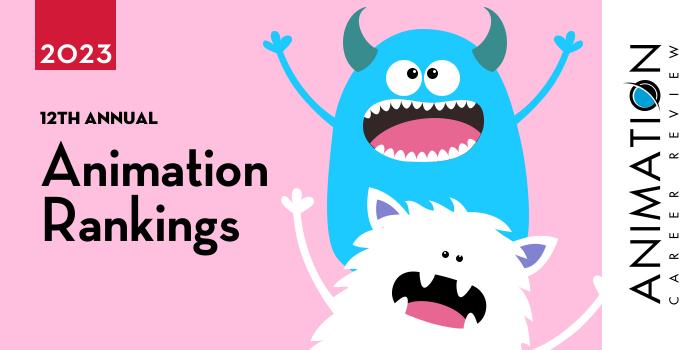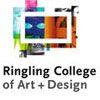
The Bachelor of Fine Arts in Digital Animation from Kennesaw State University prepares students for careers in animation and animation-related industries, or graduate school with a rigorous program in digital animation. Learn more.

| Ranking | School | State |
|---|---|---|
| 1 | Savannah College of Art and Design | Georgia |
| 2 | Ringling College of Art and Design | Florida |
| 3 | Full Sail University | Florida |
| 4 | University of Central Florida | Florida |
| 5 | Florida State University | Florida |
| 6 | Clemson University | South Carolina |
| 7 | University of Florida | Florida |
| 8 | University of North Carolina School of the Arts | North Carolina |
| 9 | North Carolina State University | North Carolina |
| 10 | The Digital Animation & Visual Effects School | Florida |
| 11 | East Tennessee State University | Tennessee |
| 12 | Middle Tennessee State University | Tennessee |
| 13 | Lipscomb University | Tennessee |
| 14 | Louisiana State University | Louisiana |
| 15 | University of South Florida | Florida |
| 16 | Tulane University | Louisiana |
| 17 | University of North Carolina Wilmington | North Carolina |
| 18 | East Carolina University | North Carolina |
| 19 | University of Tampa | Florida |
| 20 | University of South Carolina | South Carolina |
| 21 | Kennesaw State University | Georgia |
| 22 | Louisiana State University-Shreveport | Louisiana |
| 23 | Jacksonville University | Florida |
| 24 | University of North Carolina-Charlotte | North Carolina |
| 25 | University of Louisiana at Lafayette | Louisiana |
Our 2023 list -our twelfth annual- of the Top 25 Animation School Programs in the South. For reference, we define the South as Florida, Georgia, Alabama, Louisiana, North Carolina, South Carolina, Kentucky, West Virginia, Tennessee, Mississippi, Arkansas. For an explanation of ranking criteria, click here.

The School of Animation and Motion at Savannah College of Art and Design (SCAD) houses the world’s first specialized degree in Motion Media Design, three Animation degrees, and three Visual Effects (VFX) options for students seeking an undergraduate or advanced degree. Students in all School of Animation and Motion programs have access to more than 800 networked computers along with a 60,000 square-foot, state-of-the-art digital media center consisting of a green screen lab, in-house theater, and studio environment.
Students in all programs and at all degree levels receive instruction from celebrated professors who have worked at major studios and on award-winning productions such as Ice Age, Pocahontas, and The Lion King.
Programs for animators include the BFA, MA, and MFA in Animation. Available Minors include Animation, Animated Illustration and Publication Design, and Concept Design for Animation and Games. Examples of Minors that complement the Animation Programs include Visual Effects, Technical Direction, Storyboarding, Illustration for Entertainment, Interactive Design and Game Development, and Character Technical Direction.
Incoming BFA students may enroll in Gradpath@SCAD, which provides the opportunity to earn a BFA and MA or MFA at an accelerated pace. The BFA/MA could take less than four years to complete, and the BFA/MFA can be completed in five years or less.
The 180 credit hour BFA in Animation is available at SCAD’s Atlanta and Savannah campuses. The program includes 80 hours in the major, which consists of concentrations in 2D Animation, 3D Character Animation, Storytelling and Concept Development, or Technical Animation. Students may also choose 10 hours of free electives. Course examples for the program include Collaborative Experiences in Animation, 3D Character Animation: Creatures and Quadrupeds, and Story and Concept: Seeding the Narrative.
Each student in the SCAD Animation BFA Program will complete three Film Capstone courses including Preproduction, Production, and Postproduction. An optional internship is also part of the program.
Savannah College of Art and Design’s Animation MA and MFA Programs are 45 and 90 credit hours, respectively. The MA is available at the Savannah campus and through the schools online learning platform SCADnow. The MFA is available in Atlanta, Savannah, and via SCADnow. MA students will complete courses such as Animation Aesthetics and Practice, Environment Look Development, and Computer-Generated Modeling and Design. Students will also complete a collaborative project and a final project. The graduate internship is optional.
The SCAD Animation MFA requires a graduate internship and completion of three thesis courses. Students in the program can expect to take other courses such as Drawing in Motion, Media Theory and Application, and Storyboarding and Previsualization. Completion of at least seven 500- to 700-level electives are also part of the program.
From Stop-Motion Animator to Creature Technical Director, SCAD Animation graduates have been recruited by major studios, gaming companies, and networks such as Pixar, 20th Century Fox, Sony Pictures Imageworks, Electronic Arts (EA), DreamWorks, Cartoon Network, Nickelodeon, Disney, and Lucasfilm Animation.
Founded in 1978, Savannah College of Art and Design opened in the renovated Savannah Volunteer Guards Armory in September 1979. The school began with just one classroom, an administration building, and 71 students. Today, SCAD serves more than 15,000 students across campuses in Atlanta and Savannah, Georgia, and Lacoste, France. With more than 100 degree programs and over 75 minors and certificate programs, Savannah College of Art and Design has more degree programs and specializations than any other art and design college in the U.S.
Savannah College of Art and Design is accredited by the Southern Association of Colleges and Schools Commission on Colleges (SACSCOC), the Council for Interior Design Accreditation (CIDA), and the National Architecture Accrediting Board (NAAB).

The Computer Animation BFA at Ringling College of Art and Design (RCAD) was established in 1990. Consisting of 120 credit hours of study, the program features courses taught by accomplished professionals in the field, complemented by communications with visiting artists and industry guest speakers from major studios such as DreamWorks.
Students in RCAD’s Computer Animation Program have the opportunity to complete an internship and work with area businesses on practical projects. In addition, all RCAD students participate in the school’s initiative known as INDEX (Industry Experience). Developed by in partnership with The Patterson Family Foundation, the initiative provides experiential learning opportunities through everything from internships to competitions sponsored by major brands and clients. INDEX also helps students build their portfolios and resumes.
Another degree option for individuals looking to launch a career in animation is RCAD’s Motion Design BFA. This program covers animation, design, stop motion, and sound. Motion Design students have the opportunity to collaborate on projects in teams and attend the week-long FutureProof conference. This event consists of workshops, presentations, and keynote speakers.
Ringling College of Art and Design Computer Animation students have won 17 Student Academy Awards since 1998. RCAD graduates have gone on to win a number of Oscars, they have launched successful careers at studios such as Pixar, DreamWorks, and Disney Animation Studios, and many have started their own companies and animation studios.
Ringling College of Art and Design is a private, not-for-profit college. Accredited by the National Association of Schools of Art and Design (NASAD) and the Southern Association of Colleges and Schools Commission on Colleges (SACSCOC), RCAD has been around for more than 90 years. Co-founded by circus baron, John Ringling the school serves more than 1,600 students enrolled in eleven majors leading to a BFA degree, two majors leading to a BA, and minor options in 10 areas.

Full Sail University’s (Full Sail) Computer Animation Program has online and on-campus options. Leading to a BS, the distance learning option takes 29 months to complete, while the campus option takes just 20 months to complete. Students in both programs will learn how to navigate the same production pipeline used in today’s major studios. Course examples include 3D Animation I-II, Visual Development, Industry Production, Technical Animation, and Character Rigging.
All Full Sail animation students are required to take two professional development seminar courses and seven project and portfolio courses covering 3D arts and computer animation. Professional development courses provide the opportunity for students to explore the computer animation industry, while learning to build their personal brand. Professional development courses are enhanced by industry guest speakers. Project and portfolio courses highlight hands-on, project-based learning, independent study, and portfolio development.
Full Sail University graduates have been credited on more than 45 Grammy-nominated projects; 2022 blockbusters such as Top Gun: Maverick, Thor: Love and Thunder, Lightyear, Jurassic World: Dominion, and Minions: The Rise of Gru; and other productions and series such Ms. Marvel, Stranger Things 4, and Obi-Wan Kenobi.
Full Sail University offers graduate certificates and programs at all degree levels in the Arts, Entertainment, Media, and Technology. The school, which opened in 1979 in Dayton, Ohio, is located just 35 minutes from downtown Orlando and Universal Studios. Serving approximately 21,000 students, Full Sail is accredited by the Accrediting Commission of Career Schools and Colleges (ACCSC).

The College of Arts and Humanities at the University of Central Florida (UCF) houses the School of Visual Arts & Design (SVAD), home to the Emerging Media Program. Degree options for animators are available at both the undergraduate and graduate levels. The Emerging Media BFA has Character Animation and Experimental Animation Tracks and the MFA has an Animation & Visual Effects Track.
Character Animation and Experimental Animation are portfolio-based, highly competitive tracks that takes two years to complete, full-time. Students in the program benefit from courses taught by industry professionals; courses in multiple areas such as storytelling, technology, art, and design; access to state-of-the-art production labs; a studio-environment that mirrors today’s professional studios; faculty mentors; and internship opportunities.
Course examples for the Character Animation Track include Digital Effects and Compositing, Visual Storytelling and Visual Development, Digital Production in Artificial Environments, Advanced 3D Animation, New Imagery in Motion Workshop, 3D Textures, and Character Animation Portfolio Review.
Course examples for the Experimental Animation Track include Advanced Experimental Animation, Experimental Animation Professional Practice, Experimental Animation Workshop, and Experimental Animation Portfolio. Students in this Track will also complete the BFA thesis project and exhibition/screening.
Both BFA Tracks allow students to work their way through the production pipeline from story creation to film completion.
The Emerging Media MFA: Animation & Visual Effects Track focuses on narrative film structure and the entrepreneurial aspects of animation as it relates to independent filmmaking, job creation, and studio employment. Program benefits include co-directing opportunities; access to state-of-the-art labs and studios; and the opportunity to create an animation and/or visual effects thesis using techniques such as stop motion, 2D and 3D computer animation, and traditional hand-drawn. This competitive program requires 60 credit hours of study, completed over three years, full-time.
Graduates of the UCF SVAD Emerging Media Programs are Animators, Effects Artists, Story Artists, Modelers, Visual Development Artists, Lighting Artists, Riggers, Technical Artists, and Texture Artists. Program alumni are employed with major studios and gaming companies such as Pixar, DreamWorks, Disney, and Electronic Arts (EA).
The College of Sciences at University of Central Florida has an additional option for animators seeking a MS degree. Housed within the College of Sciences is Nichols School of Communication & Media—home to Florida Interactive Entertainment Academy (FIEA). Established in partnership with the city of Orlando, the state of Florida, and UCF, FIEA enrolls more than 130 students annually.
UCF FIEA has an MS in Interactive Entertainment that provides the opportunity for students to work in production teams mentored by industry professionals who provide instruction in 3D animation and modeling, game design, technical art, motion capture, creative collaboration, software engineering, and more. The program requires 30 credits including 12 credit hours of core courses, nine credit hours in a specialization, a practicum, and a capstone experience. An internship is also part of the program.
University of Central Florida FIEA graduates have been hired at studios and gaming companies such as Blizzard Entertainment, Marvel, Sony, Gameloft, Nintendo, Electronic Arts (EA), Walt Disney Imagineering, DreamWorks, Universal, Google, Microsoft Studios, Industrial Light & Magic (ILM), Zynga, and many others.
University of Central Florida opened in 1968 as Florida Technological University. On the first day of classes, the school had less than 2,000 students. Today, UCF serves around 70,400 students, making it the largest university by enrollment in the state of Florida, and one of the nation’s largest universities. The school provides 240 bachelor’s degrees, 214 master’s degrees, and 81 doctorate degrees across 13 colleges. University of Central Florida is accredited by the Southern Association of Colleges and Schools Commission on Colleges (SACSCOC).

The College of Motion Picture Arts at Florida State University (FSU) has an Animation and Digital Arts Program that leads to a BFA. Students in this four year program will spend their first year completing general education requirements. For the next three years, students will immerse in the major.
Course examples for the program include Reality & Illusion in World Cinema, Motion Picture Editing, Story Development and Screenwriting, History & Practice of Visual Effects and Animation, Filmmaking, Lighting, Texturing and Rendering, and Professional Development. The FSU College of Motion Picture Arts provides close to 30 elective options for the BFA program, allowing students to pursue a variety of interests. Examples include Visual Effects (VFX), Screenwriting, Documentary Filmmaking, Film Business, and Marketing and Exhibition.
FSU Animation and Digital Arts students will have the opportunity to complete four major films (including the thesis film), and a professional internship. All FSU College of Motion Picture Arts students may participate in the Torchlight Program, which provides instruction in the financing, marketing, and distribution of films.
Florida State University BFA graduates are prepared to seek positions in the film, television, and animation industries. Potential job titles include Animator, Effects Animator, VFX Artist, CG Lighter, Animation Supervisor, Modeler, Animatics Supervisor, Rigger, and Storyboard Artist.
Founded in 1851, Florida State University serves close to 45,500 students enrolled in nearly 300 degree programs at all levels. One of the largest and oldest universities in Florida, FSU houses 16 colleges and schools at campuses across the state. Florida State University is accredited by the Southern Association of Colleges and Schools, Commission on Colleges (SACSCOC).

The College of Engineering, Computing and Applied Sciences (CECAS) at Clemson University (Clemson) houses the School of Computing—home to the Division of Visual Computing and the Digital Production Arts (DPA) Program. Pathways for animators include the DPA MFA and DPA MS. A Digital Production Arts Minor is jointly offered by the Department of Art in the College of Architecture, Arts and Humanities, and the School of Computing. Launched in 2011 the Minor requires a minimum of 15 credit hours of study.
Digital Production Arts at Clemson University encompasses dozens of disciplines. However, each DPA program pathway has its own learning objectives. The curriculum for the MFA DPA pathway blends computer science and engineering, psychology, graphic communications, art, philosophy, and performing arts. Course examples include Technical Character Animation, Physically Based Animation, Visual Foundations of Digital Production, 3D Modeling and Animation, and Special Effects compositing.
The 60 credit hour DPA MFA at Clemson no longer requires the GRE and it is the terminal degree in the field. Graduates are prepared for a range of roles in the film and animation, video, electronic gaming, and visual effects industries. Graduates have been hired at major studios such as Industrial Light & Magic (ILM), Pixar, DreamWorks, Electronic Arts (EA), Walt Disney Animation Studios, ReelFX, and Sony Pictures Imageworks.
Established in 2017, the DPA MS focuses on the technical and visual effects aspects of film production, games, and commercial video. The program includes many of the same animation courses offered in the DPA MFA, which provides many opportunities for students to develop their animation skills. Other course examples include Software Construction, Advanced Computer Graphics, Human and Computer Interaction (HCI), 2D Game Engine Design, and Virtual Reality. Six required electives allow students to explore areas such as visual narrative, drawing, improvisation, scene painting, and audio engineering.
In addition to technical roles in the animation industry, graduates of the Clemson University DPA MS Program can pursue positions such as Technical Director, Software Engineer, VR Developer, 3D Graphics Programmer, or Tool Builder in the broad entertainment industry.
Clemson University began as Clemson Agricultural College in 1893. The school serves approximately 27,340 students enrolled in more than 200 degree programs and 90+ minors across seven colleges and a graduate school. Clemson University is accredited by the Southern Association of Colleges and Schools Commission on Colleges (SACSCOC).

The College of the Arts (COTA) at University of Florida (UF) is home to the Digital Worlds Institute. Founded in 2001, the Institute began as a partnership between COTA and the College of Engineering. Today, the Digital Worlds Institute has expanded to include six additional colleges, with a focus on advanced media systems.
The Digital Worlds Institute at University of Florida has two program options for animators—a Digital Arts & Sciences BA (BADAS) and a DAS Minor. BADAS students benefit from a project-based learning environment that allows them to gain hands-on experience and team-building skills. Electives are offered in three areas: Animation, Experience Design & Production, and Game Design. UF BADAS students may choose coursework in one or more of these areas based on their interests and career goals. Students may also take electives outside of the BADAS Program. The remaining courses for the program are in the BADAS cores and general education (30%).
BADAS core courses explore areas such as 2D and 3D animation, digital storytelling, writing for interactive media, mobile games, design and production, digital visualization, game content creation, and digital technologies. Course examples include Digital Storytelling, 2D Digital Animation Techniques, Writing for Interactive Media, Advanced Digital Animation Techniques, Principles of Interaction & Usability, Design Production Studio, 3D Modeling and texturing, 3D Character Animation, and Advanced 2D Digital Animation Techniques.
Elective examples include Blockchain Innovation in Digital Arts and Sciences, Digital Tools for Arts and Humanities, and Undergraduate Research in DAS. All students must complete the senior project and a portfolio. Independent study, an internship, and production practicum are optional.
Graduates of the Digital Worlds Institute at University of Florida are prepared for positions in a variety of areas from animation, game design, and filmmaking to science and technology. Institute graduates have been hired at major studios and companies from DreamWorks Animation to Microsoft. Many graduates have also gone on to launch their own studios and freelance businesses.
University of Florida was founded in 1858 as Gainesville Academy. When it opened, the Academy has just a few students. Today, UF serves approximately 61,110 students enrolled in more than 300 undergraduate and graduate programs across 16 colleges and schools. The University of Florida is accredited by the Southern Association of Colleges and Schools Commission on Colleges (SACSCOC).

University of North Carolina School of the Arts (UNCSA) houses the School of Filmmaking and the School of Design & Production. The School of Filmmaking is home to Animation BFA, and the School of Design & Production (S&P) is stand-alone design and production conservatory that houses the Animatronics MFA.
The Animation BFA requires 121 credit hours of study. The first year consists of liberal arts and foundations courses in filmmaking. At the end of the first year, students will complete a portfolio for entry into the Animation Program. Once admitted, students will begin exploring character design, storytelling, lighting techniques, drawing, and props. Third year students will complete a three-minute animation project and begin working on the final fourth-year project. This final project consists of a five minute film that will serve as the BFA Thesis.
During the junior or senior years, students may complete an internship or independent study as well as upper level elective courses to enhance the degree. UNCSA Animation BFA students have interned at major studios such as Sony Pictures Imageworks and Stargate Studios.
Graduates of the Animation BFA Program at UNCSA have worked with Cartoon Network and Prologue Pictures, among others.
The Animatronics MFA in the School of D&P launched in Fall 2021. This hybrid, three-year program blends electronics and animation. Students will take hands-on, immersive courses that explore animatronic programming and design, engineering and infrastructure of animatronic figures, sculpting, 3D printing, and project management. Other program benefits include seminars and workshops led by professionals in the industry and access to a 100,000 square feet of state-of-the-art production space.
The Animatronics MFA Program at University of North Carolina School of the Arts culminates with a final project (thesis) conducted in collaboration with an advisor.
Graduates of the Animatronics MFA Program at University of North Carolina School of the Arts have launched their careers at places such as Nickelodeon, Universal Studios, and Walt Disney Imagineering.
North Carolina School of the Arts was established in 1963 by the N.C. General Assembly. The school opened in 1965, becoming the nation’s first public arts conservatory. North Carolina School of the Arts became part of the University of 17-campus North Carolina System in 1972, and was renamed University of North Carolina School of the Arts. Today, UNCSA serves more than 1,300 students enrolled in dozens of programs across five schools. University of North Carolina School of the Arts is accredited by the Southern Association of Colleges and Schools Commission on Colleges (SACSCOC).

The College of Design at North Carolina State University (NC State) began as the School of Architecture and Landscape Design in 1946. It was renamed the School of Design in 1948 and the College of Design in 2000. Today, the College provides programs in architecture, art and design, design studies, graphic and experience design, industrial design, and landscape architecture and environmental planning. Programs are available at all levels—including the doctorate.
Other College of Design highlights include swing studios in other majors; study abroad experiences in places such as Greece, Chile, and Prague; an interdisciplinary first-year experience; workshops; and internship opportunities.
The College of Design at NC State also has several pathways to study animation. Housed in the College’s Department of Art + Design are the Bachelor of Art + Design (BAD) and Masters of Art + Design (MAD) Programs. A 15 credit hour Art + Design Minor consisting of courses such as Animation, Three-Dimensional Design, Drawing, Color and Light, and Sequential Imaging, is also available.
Department of Art + Design programs are highly multidisciplinary, allowing students to study both traditional disciplines and emerging techniques. Examples include animation, VR/AR, visual composition, interactive and computational media, and visual effects. Electives allow additional opportunities to focus the BAD. Examples of required courses and elective options include Advanced Digital Techniques, Animation I. Art + Design Laboratory I-II, Creative Technology Studio I-III, Drawing I-II, Visualization I-II, Digital Motion, Sequential Imaging, Color and Light, Digital Modeling, Digital Representation, and Writing About Film.
Undergraduate students will move from foundation courses in the first and second years to intermediate and advanced classes in the final two years of the program. Students will leave the Bachelor of Art and Design program with a final project and a polished portfolio of their work.
The NC State MAD Program emphasizes experimental media arts and provides the same opportunities to study animation as the BAD Program does. Examples of past MAD elective options include 3D Animation, Seminar in Animation, Special Effects, Creative Coding, Digital Motion, Visualizing Narrative, Digital Modeling, Sequential Imaging, and Business of Design.
During the final years of the program, MAD students will have the option to produce a project in animation, interactive media, or other area of their choosing, or complete a research-based study or paper.
NC State Art + Design graduates work in fields such as animation, digital special effects, multimedia, illustration, filmmaking, and software design. Some graduates go on to launch their own studios and freelance businesses, while others are become art and design educators.
North Carolina State University employs more than 9,000 faculty and staff members serving 36,000+ students, making it the largest university in the University of North Carolina System. Established in 1887 as a land-grant institution focusing in agriculture and engineering, NC State offers more than 300 degree programs across 11 colleges, 68 departments, and The Graduate School. North Carolina State University is accredited by the Southern Association of Colleges and Schools Commission on Colleges (SACSCOC).

The Digital Animation & Visual Effects School (DAVE School) has several programs for animators looking to enter the entertainment industry. Options include Visual Effects Production (VFX), Game Production, and Virtual Production. Programs lead to a Diploma or a Bachelor’s degree.
DAVE School Diploma programs take 12 or 18 months to complete, and bachelor’s degree programs may be completed in 32 or 36 months. Through electives, students in all programs have the opportunity to learn and work in animation. Students will master industry software such as Unreal Engine, After Effects, and Maya, while immersing in the production process from concept to finished works.
Course examples across all programs include 3D Animation, Digital Compositing, Visual Effects, Level Design, 2D/3D Tracking, Lighting and Texturing, and Demo Reel and Portfolio Creation. Students will also learn the basics of creating a start-up.
All programs are offered in a hybrid format where students will complete the curriculum virtually and via studio residencies at the Orlando campus. Residencies take place in a collaborative studio environment.
Graduates will leave The DAVE School with the experience needed to launch their own studios and freelance businesses or pursue employment at major studios. Possible job titles include (but are not limited to) Animator, Technical Artist, Rigger, Environment Artist, and 3D Modeler.
The Digital Animation & Visual Effects (DAVE) School was founded in 2000. Located on the backlot of Universal Studios, Florida, The DAVE School is an academic unit of NUC University, which is accredited by the Middle States Commission on Higher Education (MCSHE). DAVE serves around 1,000 students enrolled in six programs leading to a Bachelor’s degree or Diploma.

The Digital Media (DIGM) Department at East Tennessee State University (ETSU) has National Association of Schools of Art and Design (NASAD) accredited program that provides the opportunity to study animation. Housed in the College of Business and Technology, the Department emphasizes hands-on learning and technical skills development. Students in all DIGM programs will learn and work in the Niswonger Digital Media Center and the Millennium Center—a shared space with the ETSU Computing Department.
Specific program options for animators include the Digital Media BS, MFA, and Minor. The 24 credit hour DIGM Minor consists of four required courses (four credits each) and eight credits of approved electives. Required courses include Digital Animation, Visual Effects and Motion Graphics, Digital Game Design, and Visualization. Electives allow students to create an emphasis in a specific area of specialization in Digital Media.
The Digital Media BS has Digital Animation Concentration that consists of 28 credit hours of study out of the 120 required credits for the program. Course examples for the program include Digital Animation, Visual Effects and Motion Graphics, Digital Game Design, 3D Animation, Effects Animation, Character Animation, Technical Direction, High-Fidelity Modeling for Entertainment, Visual Effects Compositing, and Raster-Based Imaging. DIGM BS students will also complete several projects and a professional portfolio of their work during the final course in the program—Portfolio Development for Digital Media.
Graduates of the ETSU BS Digital Media/Digital Animation are well-positioned for careers in 2D or 3D animation, technical direction, motion graphics, and character animation, among others. Graduates are also prepared to pursue an advanced degree at ETSU or other university.
The Digital Media MFA at East Tennessee State University is a terminal degree designed for Animators, Visual Effects Artists, Cinematographers, Coders, UI/UX Designers, 3D Designers, Creature Artists, Character Animators, and other related professionals with a bachelor’s degree. This non-thesis degree program allows students to complete 12 credit hours of study in any area. An additional 12 credit hours are dedicated to team projects for both internal and external clients, and another six credits are dedicated to experimental media.
The culminating experience for the ETSU DIGM MFA allows students to develop and finalize a body of work for peer and faculty review.
Graduates of the DIGM Programs at East Tennessee State University have worked on productions and games such as Kung Fu Panda, World of Warcraft, The Last Jedi, The Walking Dead, Thor: Ragnarok, Halo, and Charlie Brown. Program alumni are Animators, Technical Directors, Modelers, Advertising Designers, Level Designers, Game Artists, VFX Artists, 3D Artists, and Compositors. They work at studios big and small such as Ubisoft Red Storm, Luma Pictures, Idol Minds, and Volition.
East Tennessee State University was established in 1911 as East Tennessee State Normal School. The school serves approximately 13,740 students enrolled in more than 140 academic programs leading to degrees at all levels. ETSU programs are housed across eleven colleges and schools, and two campuses.

The Animation Program at Middle Tennessee State University (MTSU) is accredited by the National Association of Schools of Art and Design (NASAD). Housed in the College of Media and Entertainment’s Department of Media Arts, the program is designed for artists seeking a career in character animation, visual effects, motion graphics, virtual production, video games, or visualization. Students may enroll in the Animation BS Program or the 18 credit hour Animation Minor.
Consisting of 120 credit hours, the Animation BS includes courses such as 2D Animation, History of Animation, Visual Effects, Texturing, Lighting, and Rendering, Motion Graphics, Animation Mechanics, Character Modeling and Rigging, Bodies in Motion, and Animation Preproduction. Professional Practices in Animation and Animation Capstone I &II are also part of the program curriculum. The Capstone consists of an original animated short film that will be submitted to film and animation festivals locally, nationally, and around the world.
Middle Tennessee State University was established in 1909 as Middle Tennessee State Normal School. The school opened with 125 students on September 11, 1911. Today, MTSU serves more than 20,000 students enrolled in 300+ programs across eight undergraduate colleges and the College of Graduate Studies. Middle Tennessee State University is accredited by the Southern Association of Colleges and Schools Commission on Colleges (SACSCOC).

George Shinn College of Entertainment & The Arts at Lipscomb University offers BA, BFA, in Animation and an MFA in Film and Creative Media with a focus in Animation. An Animation Minor consisting of 18 credit hours of study is available.
Lipscomb University is the only institution in the world with five former Disney Animators on faculty. Their works include: Lion King, Mulan, Aladdin, Pocohantas, Beauty and the Beast, Winnie the Pooh and Tiger Too, Lilo and Stitch and many others. Course examples across all animation programs include 2D Character Animation, Character Design, Animation Tools Storyboarding for Animation, CG Modeling and Lighting, and Computer Animation.
BA students will complete 52 credit hours in the major, and BFA students will complete 64. Students in the BFA program must complete the Animation Capstone to graduate. The 62-hour MFA is a terminal degree allowing for a college appointment.
Animation students will also attend classes with Film students, which provides multiple opportunities to train in many areas of film production. Students in all programs have opportunities to travel to places such as Los Angeles to attend animation events or complete an internship. In addition, each semester, Lipscomb University welcomes industry experts to speaking events designed to help students get an idea of what it’s like to work in some of the world’s top animation studios.
The MFA offers a range of advanced courses. Examples include Directing Animation, Advanced Film Business, Sound & Voice Performance, Digital Entertainment Law, Film Direction, 2D/CG Animation Pipeline, AD & Set Management, and CEA Studios Internship.
MFA students will complete a short film or TV pilot, to be screened at the end of the final semester before graduation.
Lipscomb University was founded in 1891 by ministers David Lipscomb and James A. Harding as Nashville Bible School. The school serves nearly 5,000 students enrolled in more than 240 undergraduate majors and minors, master’s degrees, and doctoral programs in 10 colleges. Lipscomb University is accredited by the Southern Association of Colleges and Schools Commission on Colleges (SACSCOC).

The School of Art at Louisiana State University (LSU) is part of the LSU College of Art and Design. The School has several pathways to study animation including BFA and MFA degrees in Studio Art with a Digital Art Concentration, a Digital Art BA, and the Master in Digital Media Arts & Engineering (DMAE).
For students in related majors seeking a digital art minor or those interested in a short program, the LSU School of Art has an arts-oriented Digital Media Art Minor (DMART) and a technology-oriented Digital Media Arts and Engineering Technology (DMAET) Minor. In addition to the School of Art, the DMAET Minor is provided in partnership with the Manship School of Mass Communication, the School of Music and the Departments of Computer Science, Electrical & Computer Engineering, and English.
Both Minors are interdisciplinary and consist of 21 credit hours, including 12 credit hours of electives. Course examples across programs include Moving Image, 3D Animation, Interactive Computer Graphics, Video Game Design, Computer Music, and Screenwriting Workshop. A three credit hour Capstone is also part of both programs.
The LSU Studio Art-Digital Art BFA provides instruction and training in Animation, 3D Modeling, Visual Effects (VFX), Games, and Experimental New Media Art. Course examples include Virtual Space and Motion, Two-Dimensional Design, Moving Image, Creative Coding, Digital Art, and Three-Dimensional Design.
The Studio Art-Digital Art MFA is an experimental program that allows students to blend courses that explore computational artmaking with coursework in animation, film, computer science, painting, electronic music, and more. Graduate MFA students will complete 60 credit hours, with 12 general electives to be taken in any specialization, and nine in an area of focus. Six credit hours are devoted to Thesis Research.
The interdisciplinary Master in DMAE is part of the College of Art & Design-School of Art and the College of Engineering. This intensive, two-year program explores Animation, Video Games, and VFX. Course examples include Principle Production Workshop, Digital Media Production & Project management, Advanced Programming & Digital Art, Interactive Production Team I-II, and Interactive Design, Rapid Prototyping, and Innovation. Electives allow students to take additional animation courses or other courses of interest. A Digital Media Internship also part of the Master in DMAE Program as well as a Capstone
Students in all School of Art Programs at Louisiana State University have access to the Arts, Visualization, Advanced Technologies and Research (AVATAR) Initiative, and they have the opportunity to join the Digital Art and Design Association (DADA), which hosts the Annual Animation Jam.
Louisiana State University was founded in 1860 as the Louisiana State Seminary of Learning and Military Academy. The flagship institution of the Louisiana State University System, LSU serves more than 35,000 students enrolled in over 330 programs across 18 colleges, schools, and centers, and LSU Online. Louisiana State University is accredited by the Southern Association of Colleges and Schools Commission on Colleges (SACSCOC).

The College of the Arts at the University of South Florida (USF) houses the School of Art & Art History, home to the Studio Art Program, which has a specialization in Animation and Digital Modeling. Programs in the School lead to a BA, BFA, or MFA in Studio Art. A 24 credit hour Minor in Studio Art is also available. All programs, including the minor, allow students to specialize in Animation and Digital Modeling.
All Studio Art students will explore 2D and 3D animation, digital imaging, video, games, film, fine art, and virtual 3D production. Course examples across pathways include Video, Animation, & Digital Arts (VADA) and Advanced VADA, Selected Topics in VADA, 3D Animation, Digital Modeling, Computer Animation, Tech Essentials, Visual Arts, RealWorld, Graduate Seminar, and Professional Practices.
USF BFA students will complete a senior thesis along with an internship and/or a study abroad experience, while graduate students will complete an MFA research project. BA students have the following options totaling two credit hours: Extended Studies, Artists Internships/Apprenticeships, The Paris or London Middlesex Program, Public Art, Museum Internships, or Community Art.
Students in all Studio Art Programs at the University of South Florida may explore courses in other disciplines within the School of Art & Art History. Graduates of the Studio Art Programs at University of South Florida have established careers in animation, television and film, advertising, art, education, science, medicine, and games, among others.
Founded in 1956, University of South Florida serves more than 50,000 students at its campuses in Tampa, St. Petersburg, and Sarasota-Manatee. Students have access to 200+ undergraduate programs and over 150 graduate, specialist, and doctoral programs. The degree programs at USF are offered across 14 colleges from Arts to Engineering to Public Health. The University of South Florida is accredited by the Southern Association of Colleges and Schools Commission on Colleges (SACSCOC).

Both undergraduate programs begin with the Foundations of Art Series. Students will complete a number of projects throughout the program. Studio Art BA students will complete a Senior Capstone to graduate, while BFA students will complete a final major project. Final works will be presented at the Carrol Gallery located in the Woldenberg Art Center- Newcomb Art Department.
The interdisciplinary Studio Art MFA focuses on individual studio practice and cross-disciplinary seminars. Graduate students will participate in the Thesis Show, where each artist will exhibit a culminating body of work in the Carrol Gallery.
Tulane University was established in 1834 as Medical College of Louisiana. Serving approximately 14,475 students today, Tulane was the first major research institution to require public service for graduation. More than 75 different undergraduate majors are offered within five undergraduate schools, along with dozens of graduate programs across Tulane’s other five colleges and schools. Tulane University is accredited by the Southern Association of Colleges and Schools Commission on Colleges (SACSCOC).

The College of Arts and Sciences at University of North Carolina Wilmington (UNCW) is home to the Department of Art and Art History, which houses the interdisciplinary Digital Arts Program. Within the Program are two pathways for animators including the Digital Arts BA and a Minor. The Digital Arts BA has an optional Concentration in Interactive Graphics. Also housed in the College of Arts and Sciences is the Computer Science (CS) Program. CS student can add a Digital Arts Concentration, which leads to a BS in CS/Digital Art.
Students in the interdisciplinary Digital Arts BA Program will learn to design 3D graphics and interactive user experiences for film animation, VR/AR, digital art, games, and 3D animation applications. Course examples include Computer Animation, Computer Gaming, Digital Visual Effects, Life Drawing, Visual Design for Multimedia, and Computer Graphics Programming. A Digital Arts Capstone (Portfolio Project) is also part of the program. Students will complete the Capstone during the last year in the major and present it in a campus venue.
The UNCW BS in CS/Digital Art Program requires 55 credit hours in the CS Core and 24 credit hours of study in the concentration. Course examples for the program include Computer Networks, Design and Analysis of Algorithms, Programming Languages, and Software Engineering. In the concentration, students may take courses such as Computer Animation, Film Production, Digital Video Production, 3D Computer Graphics, Multimedia Systems, Graphic Design, and Tools & Literacy.
Graduates of the Digital Arts Programs at University of North Carolina Wilmington are prepared to pursue positions at animation, VFX, and game design studios; graphic design firms; companies that specialize in using VR/AR for entertainment, training, and education; video production companies; and places that utilize HCI such as theaters, galleries, and museums, architectural firms, and engineering companies.
Established in 1946, University of North Carolina Wilmington is part of the part of the 17-campus University of North Carolina System. The school serves approximately 17,845 students enrolled in more than 100 programs across five colleges and schools. The University of North Carolina Wilmington is accredited by the Southern Association of Colleges and Schools Commission (SACSCOC).

The College of Fine Arts and Communication at East Carolina University (ECU) houses the National Association of Schools of Art and Design (NASAD) accredited School of Art and Design (SoAD). Within the school is an Art BFA Program that allows students to explore different disciplines, while focusing on a concentration in a specific area. For artists seeking a pathway to study animation, the Art BFA Program has an Animation/Interactive Design Concentration.
All SoAD concentrations are supported by a guild that provides activities to enhance the curriculum. Guild activities include visiting artists and designers for talks and workshops, student travel to conferences, research opportunities, and support on creative projects. Other program benefits include partnerships with local arts organizations, hands-on learning, internships, study abroad opportunities, and access to career development services.
The Art BFA at East Carolina University requires 30 credit hours in the concentration. Coursework for the Animation/Interactive Design Concentration explores animation, video art, game design, and interactive design. Students will complete a senior exhibition, portfolio, reel, or film to graduate from the program. This culminating experience prepares students to pursue a variety of professional roles in animation, games, TV/film, and advertising, among others.
Chartered as East Carolina Teachers Training School in 1907, East Carolina University is the only public university in the state with a dental school, medical school, and college of engineering. ECU serves nearly 29,000 students enrolled in more than 200 undergraduate, graduate, and minor programs across 12 colleges and schools, making it one of the top five largest universities in North Carolina. Part of the University of North Carolina System of 17 institutions, East Carolina University is accredited by the Southern Association of Colleges and Schools Commission on Colleges (SACSCOC).

The Film/Animation/New Media (FMX) Program at University of Tampa is one of the school’s Top 20 most popular undergraduate majors. Housed in the College of Arts and Letters (CAL)-Department of Film, Animation and New Media, the major leads to an Animation BFA. An Animation Minor is also available, and both programs are accredited by the National Association of Schools of Art and Design (NASAD).
The Animation BFA is a professional degree program that explores narrative, documentary, experimental and animation filmmaking; 3D animation, printing and modeling; digital and interactive media; experimental computing; screenwriting; producing; and digital media and imaging. Course examples for the program include 2D Animation I-II, 3D Animation I-II, Animation and Interactivity for Games, Visual Effects, Creative Coding, Game Design and Production, Screenwriting Shorts, World Animation, Virtual Production, and Experimental Filmmaking.
Other program benefits include hands-on studio classes; the FMX 374 Internship, which provides opportunities to intern at both local or worldwide studios such as Sony, Diamond View Studios, and Theory Studios; the opportunity to work on film shoots in the Tampa Bay area; and access to artists and filmmakers through the FMX Filmmaker and Artist Series.
During the final years of the Animation BFA Program, students will complete the Professional Seminar course, Junior Portfolio Review, and the Senior Project in FMX.
Graduates of the Animation BFA Program at University of Tampa are prepared for graduate study or a career in animation, TV/film, advertising, game design, or interactive media. Program alumni have been hired at places such as LAIKA Studios, Big Fish Entertainment, and The Divine Saga Studios.
Founded in 1931, University of Tampa opened as Tampa Junior College with just 62 students. Today, UT serves approximately 10,565 students from all 50 states and 130 countries. UT offers more than 200 academic programs of study across four colleges including Arts and Letters; Natural and Health Sciences; Social Science, Mathematics and Education; and Sykes College of Business. University of Tampa is accredited by the Southern Association of Colleges and Schools Commission on Colleges (SACSCOC).

The School of Visual Art and Design (SVAD) at University of South Carolina (UofSC) has several pathways to study animation. Options include BA and MA degrees in Media Arts, and a Media Arts Minor. The Minor requires 18 credit hours of study and it is open to students in any undergraduate program. With an emphasis on modern media production and hands-on experience, the program allows students to create a focus by selecting 12 credit hours of electives.
Across all SVAD Media Arts Programs, students will take courses such as Animation, Digital Media Arts Fundamentals, The Moving Image, New Media Art, Sound for Motion Picture, Video Game Design, Experimental, Manga and Anime, Cinematography, Media Performance, and Digital Imaging. Courses are hands-on and immersive, and led by instructors who are professionals in their respective fields.
Other SVAD highlights include access to an 85,000-square-foot facility that includes an animation lab, lighting and sound studios, a green screen stage, a virtual reality lab, and several computer labs; an internship with a top local or global studio; the opportunity to declare a focus in an area such as Animation, Games, or Cinematography; and participation in UofSC’s study abroad program.
Graduates of the Media Arts Programs at University of South Carolina have been hired at major studios and companies across the U.S. Examples include Blizzard Entertainment, Nickelodeon, Marvel, ABC, Showtime, HBO Films, Netflix, Amazon Studios, and NBC.
Established in 1801 as South Carolina College, University of South Carolina is one of the nation’s oldest public universities. Part of the eight-campus University of South Carolina System, UofSC provides more than 300 areas of study to a population of nearly 35,400 students. Programs are offered across 16 colleges and schools. University of South Carolina is accredited by the Southern Association of Colleges and Schools Commission on Colleges (SACSCOC).

Kennesaw State University (KSU) houses the School of Art and Design (SOAAD), which serves more than 1,200 students. Within the SOAAD is a Digital Animation BFA Program that requires 120 credit hours of study. This professional degree program focuses on intensive work in digital animation with 42 general education core credit hours. Course examples for the program include Computer Applications in Art, Concept, Creativity, and Studio Practice, History of Comics, Cartoons, and Animation, Environments for Animation, Digital Animation Production, Digital Animation Studio I-III, and Electronic Illustration.
Upper level BFA students will complete a series of advanced courses, an Art Internship, and ANIM 4660: Senior Animation Reel. The Reel Course consists of two class hours, four laboratory hours, and three credit hours, with a focus on the development of a portfolio and professional animation reel. Students will also research current job market demands and requirements, and prepare for a salaried or freelance career in the animation industry, or graduate study.
At the graduate level, Kennesaw State University has an Art and Design MA (MAAD) with a Digital Animation Concentration. Consisting of 30 credit hours, this interdisciplinary program explores frame-to-frame animation, storyboarding, rigged animation, and visual development for films and games. Course examples include Creative Problems in Digital Animation I-II, Research for Commercial Creatives, Exploration of Visual Arts, Ideation and Iteration for Creatives, Technologies, Innovation, & Design Thinking, and Emoting and Communication for Creatives.
All KSU MAAD students will have the opportunity to complete a final project or thesis. The Kennesaw State University Art and Design MA may be completed entirely online in just one year. Graduates are prepared to launch their own studios, start a freelance career, or pursue a position in animation, digital design, interactive art, advertising, games, and many other fields.
Founded in 1963 as a junior college, Kennesaw State University (KSU) serves nearly 43,000 students, making it the third largest university in Georgia. More than 180 degree and certificate programs are offered across 11 colleges, KSU Journey Honors College, and two suburban campuses in Kennesaw and Marietta, Georgia. Kennesaw State University is accredited by the Southern Association of Colleges and Schools Commission on Colleges (SACSCOC).

Louisiana State University-Shreveport (LSUS) has two pathways to study animation. In the Digital Media and Arts Department, students can enroll in the Digital Arts BFA Program. The Computer Science Department has a Digital and Interactive Design Concentration within the Computer Science BS Program. Both options can be completed four years.
The Digital Arts BFA Program explores 2D and 3D animation, digital illustration, game design, Photoshop, drawing, painting, and more. Fifteen credit hours of electives allow students to focus in areas such as animation, game design or graphic design. Other program highlights include hands-on learning in a collaborative environment, internship opportunities with local companies and studios, and the chance to join ACM SIGGRAPH, the American Advertising Federation, and/or the Game Development Club. All provide opportunities to participate in workshops and network with other artists and professionals.
The Computer Science BS with a Digital and Interactive Design Concentration prepares students for technical roles in the animation and visual effects industries. CS students work and learn in technology-enabled classrooms and state-of-the-art labs dedicated to animation, bio-informatics, computer game development, and network security. Students in the CS Program also have the opportunity to rub elbows with representatives from companies such as Cisco, Kobus Technologies, and Ingalls during the Department’s monthly Lunch & Learn event.
Students in both the BFA and BS Programs will graduate with a resume and a professional portfolio of their best work. Graduates of the Digital Arts and CS Programs at Louisiana State University-Shreveport are prepared for careers in animation, game art, artificial intelligence (AI), game development, software design, visual effects, advertising and marketing, film and video production, and graphics, among others.
Part of the Louisiana State university System, Louisiana State University-Shreveport began in 1967 as a two-year college. Serving close to 10,000 students, LSUS offers more than 20 undergraduate degree programs, a dozen master's degree programs, and a Doctorate of Education (Ed.D.) in Leadership Studies. Louisiana State University-Shreveport is accredited by the Southern Association of Colleges and Schools Commission on Colleges (SACSCOC).

Linda Berry Stein College of Fine Arts & Humanities (Stein College of Fine Arts) at Jacksonville University (JU) houses the School of Art & Design, which has several pathways to study animation. At the undergraduate level, the Animation Program has BFA and BS options. At the graduate level, JU has a Visual Arts MFA that allows students to practice in any area or create an interdisciplinary program from 11 areas of study. Examples include Animation, Film, Illustration, Mixed Media, and Visual and Graphic Design. Low-residency and no-residency options are available, and MFA students may choose from two-year and three-year course plans.
In addition to the BFA and BS Programs, the School of Art & Design has an Animation Minor consisting of six courses. Students will take Character Modeling & Animation, Computer Animation, Animation Rendering, Animation Production, Digital Art, and 3D Modeling and Design. Each course is worth three credits.
In addition to the courses included in the Minor, Animation BFA students will take Animation Effects, Digital Art, Time Based Arts, Advanced Production, Editing, and 2D and 3D Art Foundations. Animation BS students will the same courses, as well as Film, Engineering Graphics, Computer Aided Design, and Design Process & Prototyping. The internship program is open to both BS and BFA students.
Graduates of the Animation and Visual Arts Programs at Jacksonville University are Animators, Modelers, Motion Graphic Artists, Game Animators, Game Artists, Texture Painters, Visual Effects Artists, and CAD Artists, among others.
Founded in 1934, Jacksonville University serves 4,222 students from all 50 states and 33 countries. Some 100+ academic majors, minors, and programs are offered across seven colleges and institutes. Jacksonville University is accredited by the Southern Association of Colleges and Schools Commission on Colleges (SACSCOC).

The College of Arts + Architecture (COA+A) at University of North Carolina Charlotte (UNC Charlotte) houses the Department of Art & Art History. Within the Department is one pathway to study animation. Consisting of 120 credit hours, the Department’s Art Program has a Digital Media Concentration that requires 79 credit hours in the major. Course examples include 3D Modeling and Animation, Animation Production, Video Art, Interactive Art and Design, Digital Compositing, Advanced 3D Modeling and Digital Fabrication, Game Design and Graphics, and Topics in Digital Media.
All Art Program students will complete Senior Seminar, and Senior Thesis I and II. The Art BFA is a professional degree program that takes four years to complete.
Students will graduate from the UNC Charlotte Art Program with a professional portfolio of their best work. Program alumni are prepared to pursue careers in areas such as animation, film and video, television, advertising, multimedia design, and web design.
University of North Carolina Charlotte is accredited by the Southern Association of Colleges and Schools Commission on Colleges (SACSCOC). Founded in 1946, UNC Charlotte serves approximately 29,550 students enrolled in more than 200 undergraduate, graduate, and doctoral programs across nine colleges. University of North Carolina Charlotte is a public research university and the third largest school in the 16-campus UNC System.

The Department of Visual Arts at University of Louisiana at Lafayette (UL Lafayette) houses the oldest established Computer Animation Program in the state of Louisiana. Part of the College of the Arts, the animation program launched in 1992. Today, the Computer Animation Program at UL Lafayette can be taken as a Concentration within the Visual Arts BFA Program.
The Computer Animation curriculum is taught in a studio environment equipped with industry software such as Adobe Creative Suite and Maya, as well as classrooms, workstations, Mac computers, digital cameras and projectors, and more. Students also have access to the Animation and New Media & Digital Art studios equipped with compositing and editing software, a Green Screen production studio, and a video/audio system.
The Computer Animation Concentration explores animating, concept development, video and audio editing, scriptwriting, creating animatic studies, storyboarding, and compositing. The program also emphasizes hands-on computer experience, animation history, and contemporary works and theory in animation.
During the final year of the program, students will complete the Senior Capstone Art Project consisting of two courses totaling six credit hours and 12 lab hours. The project leads to a completed professional portfolio and exhibition.
Graduates of the Visual Arts BFA/Computer Animation Program at UL Lafayette have worked on numerous projects for Pixel Magic in Lafayette, Louisiana. Examples include The Chronicles of Narnia: The Voyage of the Dawn Treader, Men in Black, Looper, Harry Potter and the Deathly Hallows Part One and Part Two, Looper, and The Twilight Saga: Breaking Dawn Part One.
University of Louisiana at Lafayette was established in 1898 as the Southwestern Louisiana Industrial Institute. The school serves approximately 18,865 students, making UL Lafayette the second largest university in Louisiana. University of Louisiana at Lafayette provides more than 300 programs across 14 colleges and schools. The University of Louisiana at Lafayette is accredited by the Southern Association of Colleges and Schools Commission on Colleges (SACSCOC).